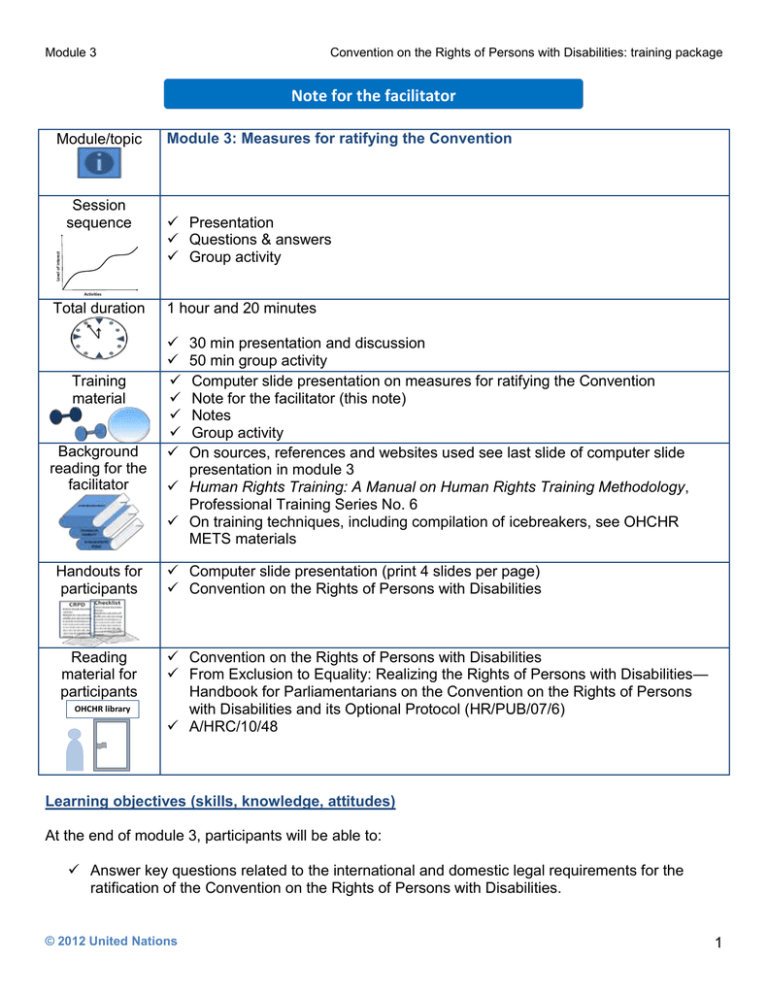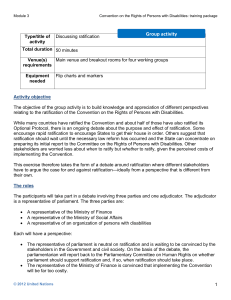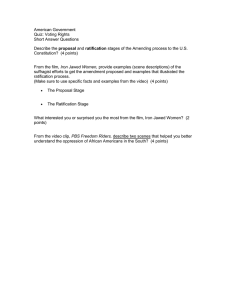Note for the facilitator
advertisement

Module 3 Convention on the Rights of Persons with Disabilities: training package Note for the facilitator Module/topic Level of interest Session sequence Module 3: Measures for ratifying the Convention Presentation Questions & answers Group activity Activities Total duration Training material Background reading for the facilitator Handouts for participants Reading material for participants OHCHR library 1 hour and 20 minutes 30 min presentation and discussion 50 min group activity Computer slide presentation on measures for ratifying the Convention Note for the facilitator (this note) Notes Group activity On sources, references and websites used see last slide of computer slide presentation in module 3 Human Rights Training: A Manual on Human Rights Training Methodology, Professional Training Series No. 6 On training techniques, including compilation of icebreakers, see OHCHR METS materials Computer slide presentation (print 4 slides per page) Convention on the Rights of Persons with Disabilities Convention on the Rights of Persons with Disabilities From Exclusion to Equality: Realizing the Rights of Persons with Disabilities— Handbook for Parliamentarians on the Convention on the Rights of Persons with Disabilities and its Optional Protocol (HR/PUB/07/6) A/HRC/10/48 Learning objectives (skills, knowledge, attitudes) At the end of module 3, participants will be able to: Answer key questions related to the international and domestic legal requirements for the ratification of the Convention on the Rights of Persons with Disabilities. © 2012 United Nations 1 Module 3 Convention on the Rights of Persons with Disabilities: training package Approach to module 3 Module 3 focuses on the ratification of the Convention on the Rights of Persons with Disabilities and its Optional Protocol. Ratification—whether national or international—raises some little-known technical and procedural issues. However, given that there are some 90 States that have yet to ratify the Convention and even more that have yet to ratify its Optional Protocol, it is important to cover this here. The module should raise awareness of the procedure of ratification and its implications and, in doing so, demystify the process. In addition, it should help stimulate thinking about how to go about ratification—whether for non-governmental organizations (NGOs) considering advocacy or government employees thinking of promoting ratification internally. General tips It is expected that the facilitator will adapt the materials to the audience and to the national or regional context. The computer slide presentation and the notes are provided as a basis upon which the facilitator can build a training course that suits the participants’ requirements and specificities. There is no need to follow the presentation and notes slavishly! Some practical examples are contained in the notes; however, when preparing the presentation the facilitator should have some additional examples on hand, based on his/her own experience and research that take into account domestic and regional situations and information sources. The facilitator should encourage as much discussion and interaction as possible. Specific slides Slide 1 – title Slide 2 – objectives and module flow Slide 3 – sets out a basic definition of the term “ratification”. “Consent to be bound” by a treaty can be achieved through “ratification”, “accession” or “formal confirmation” depending on which entity (State or regional integration organization) is providing its consent to be bound and also the constitution of the country in question. However, it is proposed that the facilitator does not go into this level of detail for this slide. Instead, the term “ratification” is used in slide 3 in a lay sense to refer to “consent to be bound” so as to avoid being overly technical. If the participants are lawyers, the facilitator may change this slide and make it more technical Slide 4 – sets out the status of ratifications and should be updated for the training in the light of new ratifications. The status of ratifications is available at: http://treaties.un.org/Pages/Treaties.aspx?id=4. Slide 5 – intends to encourage participants to think of all the various stakeholders that could and should be involved in the national and/or international ratification process. Slide 6 – focuses on some of the factors that can influence ratification. In many countries, lobbying by civil society is the main factor. However, some countries undertake national consultations and even national analyses of laws and policies to identify protection gaps before deciding to ratify or not © 2012 United Nations 2 Module 3 Convention on the Rights of Persons with Disabilities: training package Slide 7 – identifies how civil law countries and common law countries have different approaches to national ratification. It is important to highlight that, even within a particular system of law (civil law, common law), the approaches can be very different so each participant should understand his or her system if this is not already the case. This slide might appear quite technical to some (some participants might not know whether they have a civil law or common law system, for example). However, it is important for participants to understand the process for national ratification if they are going to have any influence on it and so the facilitator should make a point of explaining it. Slide 8 – sets out the different options for a country to express its consent to be bound by the Convention internationally. This can be confusing to many participants. For example, participants might ask why one country would “sign” then “ratify” the Convention while another would “accede” and wonder what the difference is between these options in any case. The facilitator should be prepared for these questions, which might involve examining national constitutions of the country or region in which the training course is taking place. Slide 9 – explains the terms “declarations” and “reservations”. The facilitator should: (a) use examples to discuss this—several examples are provided but the facilitator should do some research to provide local examples where relevant; (b) emphasize that reservations are to be discouraged! Slide 10 – examines the impact of international ratification on different countries. Again, this is quite complicated and many participants will be surprised that ratification has different effects on different countries. Some participants could ask whether, after ratification, they can force the Government to respect the Convention. This will change from country to country and the facilitator should prepare so that he or she can provide a locally relevant answer. Slides 11–16 – set out relevant steps or suggestions for different actors on how to support the Convention Slide 17 – provides sources of additional information © 2012 United Nations 3


